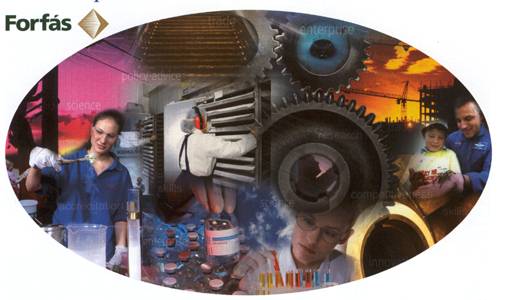| 2003 |

|
YEAR BOOK |
Forf�s
|
The European Research and Innovation Area
|

The ERIA is envisaged as a tool to overcome Europe's main weaknesses compared to its competitors (mainly the USA and Japan) namely:
-
Insufficient funding - the average research effort in the EU is only 1.9% of GDP, compared with 2.8% in the USA and 3% in Japan;
-
The European 'paradox' - while European research laboratories perform relatively highly in publications and citations, there is a lack of an environment that stimulates innovation and exploits results;
-
Fragmented activities and dispersed resources.
Objectives
Against this background, the objective of the European Research and Innovation Area combines three inter-related and complementary concepts:
|
��Creation of an internal market in research - an area of free movement of knowledge, researchers and technology aiming to increase cooperation, to stimulate competition and to achieve better allocation of resources;
��Re-structuring of the European research framework by improving coordination of national research activities and policies; ��Development of a European research policy that will reach beyond research activities, taking into account all relevant aspects of other EU policies. |
In order for the EU to achieve the goal of becoming the world's leading knowledge economy by 2010, the contribution of each Member State to raising the Community's performance will matter. At the Barcelona Summit in 2002 the Heads of State specified how much individual contributions will matter by setting a target of an EU average for investment in R&D of 3% of GDP by 2010.
Individual Member States will be required to adopt their own targets, with a specified two-thirds of this investment to come from industry. This reflects the concern that a key area of weakness in the EU innovation system is the absorptive capacity of industry.
Developing Ireland's National Innovation System
The European Union has played a crucial role in shaping and priming the development of national S&T structures in Ireland. Access to EU Structural Funds since the end of the 1980s provided a large, albeit now declining, proportion of resources for new S&T endeavours. EU programmes have provided opportunities to collaborate with European partners in leading edge research. EU support has also led to the significant upgrading of national S&T infrastructures and to encouraging more innovation in companies.
In line with the blueprint set out in the Culliton Report (1992) on industrial policy, and under the first two Operational Programmes for Industry, substantially co-financed by the EU, the general thrust of industrial policy in the decade 1989 to 1999 was to develop sectors characterised by high levels of innovation, quality, productivity and value-added. The Productive Sector Operational Programme in the National Development Plan, 2000-2006, indicates how current policy to develop the knowledge-base of the economy and build the level of higher value-added activities in foreign-owned industry is being implemented. In addition, Irish third level institutions, researchers and companies have benefited from participation in successive EU research and development programmes.
Responding to the ERIA Challenge
As part of its strategy to develop as a knowledge and innovation-based economy, Ireland has significantly increased its investment in science and technology to build its reputation in areas of strategic importance to the country over recent years. Positioning innovation and technology at the heart of Irish enterprise development over the next decade will require a continuation of the rapid growth in Ireland's investment in science, technology and innovation. There is also a need for partnership and synchronisation of public and private investment to ensure that all elements are supported.
While the planned investment under the National Development Plan, of almost �2.5 billion over the period to 2006, will help to underpin sustainable economic development in the years ahead, current indicators show that Ireland has a considerable distance to go in bringing innovation to the heart of development policies at national, regional, local and enterprise level. Ireland's investment in research and development (R&D) is currently equivalent to 1.36% of GNP, a level substantially below that of other knowledge intensive economies, such as Sweden (3.8%), Finland (3.22%), Denmark (2.06%), Netherlands (2.05%) and the UK (1.87%). In current prices, the Government's Science and Technology Budget increased from �980 million in 1999 to an estimated �1.6 billion in 2003.
It is critical that the good progress and momentum achieved under the National Development Plan over recent years, of increased investment in research capacity and capability and establishing an international reputation for Ireland as a centre for world class research, be maintained and further developed. Certainty and stability of public funding for science, technology and research at the overall level and in the allocations of individual Government Departments are key for Ireland to build on the progress achieved.
Action Plan for Ireland
In January 2003, the T�naiste and Minister for Enterprise, Trade and Employment announced the establishment of a high level European Research and Innovation Area Steering Group, under the auspices of the Inter-Departmental Committee on Science and Technology. The Steering Group is Chaired by Mr Ned Costello, Assistant Secretary, Department of Enterprise, Trade and Employment. Research and co-ordination support is being provided by Forf�s.
The terms of reference for the Steering Group are to assess the implications of the development of the ERIA for Ireland and to advise on actions for Ireland. The Steering Group will also consider the issue of an appropriate target for Ireland in the context of the target for Europe of 3%.
The Steering Group has established three sub-groups comprising representatives of key Government Departments, agencies, the scientific community, industry and industry associations and the third level sector to address the following areas:
-
Framework conditions and environment for research and innovation;
-
Business expenditure on R&D;
-
Public Expenditure on Research.
Contact: Further details on the work of the ERIA Steering Group and Sub-Groups are available at www.forfas.ie ;
or from Dr Lucy Cusack, Forf�s; Tel: 353 1 607 3080; E-mail: [email protected]